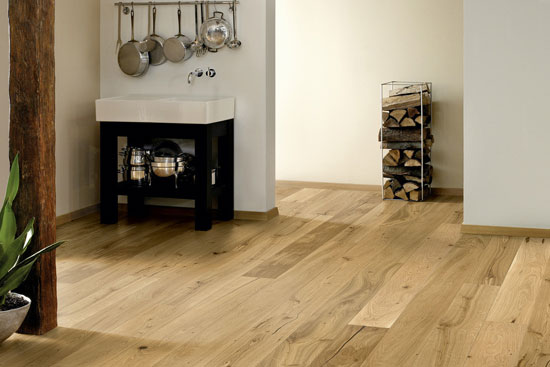Solid wood flooring, engineered wood flooring, consolidated composite flooring are the three main categories on flooring market. There is also new type flooring such as cork flooring, bamboo flooring etc. The selection method is differed for flooring material. Look how to find the right flooring wood for reference.
Selection Method for Solid Wood Flooring
1. Check the Precision of Flooring
Assemble several pieces of flooring to check the precision of groove and tongue and the height difference between neighboring flooring pieces.
2. Check the Flaw of Base Material
Observe the cross section of flooring whether the grain of panel is in disorder. Check whether there is knot, crack, rotten on the base material. As solid wood flooring is made by natural timber, chromatic aberration is common phenomenon for it.
3. Test the Water Content
The water content of wooden flooring should be 8% to 13% according to related authority specification. Test the water content of flooring in the showroom and the sealing flooring in the same material and specification. If there is only 2% difference, then the water content of the flooring is up to standard.
4. Choose Flooring with Proper Length
Flooring in medium and short length is recommended for convenient to pave and transport. What is more, the possibility of deformation for shorter flooring is lower than longer one. People need to spend more energy on paving longer flooring.
Selection Method for Engineered Wood Flooring
1. Look Appearance
Engineered wood flooring is divided into excellent, high-class and qualified. Appearance is an overarching for its grading. Check whether the luster, grain of the panel is clear, whether there is rotten, knot, worm damage, crack on the panel. The luster and grain of wood must be harmonious. Check whether the joint of tongue and groove is flat.
2. Formaldehyde Content
Engineered wood flooring is connected by splicing and bonding. The quality and environmental protection performance of adhesive has direct relation to formaldehyde content. The safe standard for flooring is E1 – the average value of formaldehyde emission lower than 1.5mg/L.
Selection Method for Consolidated Composite Flooring
1. Check Environmental Protection Certification
Consolidated composite flooring contains formaldehyde. When the formaldehyde content exceeds 1.5mg/L, it will be harmful to human’s health. Do not trust the saying of “zero formaldehyde”. The most reliable method to know whether the flooring is safe is to check the environmental protection certification and inspection report.
2. Wearing Coefficient
The wear-resistant agent for consolidated composite flooring is aluminium oxide. The content of aluminium oxide and the thickness of film decide the wearing coefficient of flooring. The higher the aluminium oxide content is and the thicker the film is, the higher the wear-resisting revolution is. The longer the service life of flooring is. The consolidated composite flooring with wear-resisting revolution no less than 6000 will mark AC3 on it. The larger the revolution is, the higher the mark is.
3. High Density of Base Material
The base material of consolidated composite flooring on market is mainly made from density board. The greater the density is, the larger the internal bonding strength is and the better the panel quality is. When select consolidated composite flooring, the whiter the base material is, the better the quality is. Press the edge of base material to check whether there is wood powder drop from it.
4. Compactness of Flooring Splicing
As keel and adhesive do not used for the installation of consolidated composite flooring, the compactness of tongue-and-groove is essential for the firmness of it. Splice two pieces of flooring at the store to check whether it is flat and joint firmly. People cannot separate the spliced flooring easily if the flooring is of high quality.
5. Thickness and Length
The thickness of consolidated composite flooring has 1.2cm and 0.8cm. 1.2cm flooring has foot feeling similar to solid wood flooring. There are 1.2m and 0.8m flooring on the market. Large flooring has better effect after paving for large room and small sized flooring can save material for small room.
Selection Method for Cork Flooring
1. Color
The quality of cork flooring is decided by the content of cork. The bark of cork is divided into three layers: black layer – the hardest part; cementation cork layer – soft white or light yellow substance; it is the essence of cork. The higher the content of cementation cork layer, the better the quality of cork flooring is. Black layer used at the back of flooring can improve shock proof performance.
2. Density
The density of cork flooring is divided into three grade: 400–450kg/m³,450-500kg/m³ and more than 500kg/m³. Usually, 400-450 kg/m³is enough for family use. When there is heavy items in home, cork flooring with high density should be used. In a word, try to use cork flooring in low density. Low density cork flooring has better elasticity, heat preservation, sound absorption and vibration absorption performance.
3. Appearance
Check whether the sanding surface of flooring is smooth, whether there is raised particle on it. Check whether the side of flooring is straight. Take four pieces of same flooring and paving them on ground to observe the compactness of joint. Check the bending strength of flooring by folding two pieces of flooring together. No crack improve the flooring is qualified. Finally, check the bonding strength. Soak small piece of cork flooring in boiled water. If the sanding surface becomes uneven, then the quality of the flooring is not proved. If you want to know more about cork flooring selection method, recommend you this article: five tips for choosing cork flooring.

